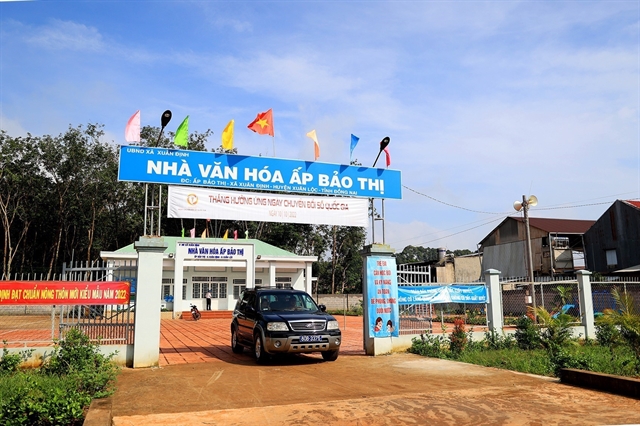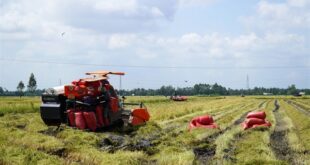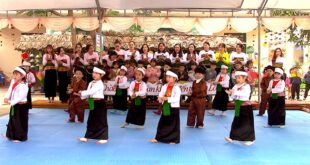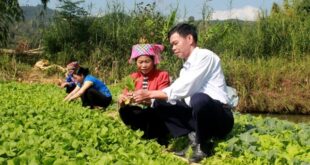 |
| The Bảo Thị Hamlet culture house in Xuân Định Commune, an exemplary new-style rural commune, in Đồng Nai Province’s Xuân Lộc District. — VNA/VNS Photo Hồng Đạt |
ĐỒNG NAI — Đồng Nai Province plans to have all of its communes recognised as advanced new-style rural ones by 2025.
The south-eastern province’s 120 communes have already been recognised as new-style rural communes under a national programme, and being recognised as advanced is a step up.
Lê Văn Gọi, deputy director of the provincial Department of Agriculture and Rural Development, said the former was achieved in 2019, and since then the focus has been on achieving advanced and exemplary status.
To attain recognition as a new-style rural commune, a commune must adhere to the programme’s 19 criteria covering aspects such as infrastructure, irrigation, electricity, environment, income, education, healthcare, social security, and culture.
Communes must meet higher standards across all these criteria to be named an advanced new-style rural commune.
Currently, the province boasts 105 advanced new-style rural communes and 30 exemplary new-style rural communes.
Exemplary communes surpass advanced ones in meeting elevated standards, and the province aims to have 25 per cent of its communes acknowledged as exemplary by 2025.
The outstanding features of the province’s advanced and exemplary rural communes include an annual per capita income of VNĐ80-90 million (US$3,300-3,700) and low poverty rates.
These areas exhibit well-invested infrastructure, predominantly paved roads, and a commitment to environmental protection and social security.
Rural communes have integrated the development of new-style rural areas with agriculture restructuring, focusing on modern, large-scale and sustainable production.
The province has created large-scale growing areas for pepper in Cẩm Mỹ, Xuân Lộc, Định Quán and Tân Phú districts, durian and rambutan in Long Khánh City and Xuân Lộc District, and mango in Vĩnh Phú, Định Quán and Xuân Lộc districts.
It has fostered linkages in the production and sales of agricultural products, involving 160 companies and co-operatives and 15,000 households.
Exemplary models, such as creating aesthetically pleasing new-style rural areas with road lamps, trimmed tree branches and proper waste disposal, have been implemented in Cẩm Mỹ District.
Vĩnh Cửu District’s communes have introduced “knowledge houses” with books and computers to benefit locals, while exemplary residential areas prioritise environmental protection and climate change adaptation.
Women in the province play a pivotal role in environmental sanitation, tree care and maintaining clean village roads.
The Women’s Union actively promotes women’s roles through campaigns like “Five No’s and Three Cleans,” focusing on poverty reduction, legal adherence, domestic harmony, family planning, and cleanliness. Women groups aligned with new-style rural development have built 283 green, clean and beautiful roads totalling over 200km.
The province has formed 116 women groups and clubs with over 3,500 members dedicated to environmental protection.
The Farmers Association also reported proactive engagement by its members, who contribute land and labour to build infrastructure.
During 2018-23, they donated cash exceeding VNĐ 209 billion ($8.6 million), 147,000sq.m of land, and 67,000 working days to enhance rural facilities.
In this period, the province achieved significant milestones, repairing 972km of rural roads, upgrading 448 irrigation canals, building 128 bridges and sewage systems, completing 1,000 power supply projects, and upgrading nearly 34,800 healthcare and education facilities.
Vĩnh Cửu District’s Bình Lợi Commune stands out as the province’s first exemplary new-style rural commune, showcasing substantial improvements in its overall appearance.
Local testimonials attest to the positive impact of the new-style rural areas programme, highlighting enhanced infrastructure, improved living conditions, and successful collaboration between local authorities and farmers to establish efficient production models and concentrated farming areas.
Top of Form
Residents of Bình Lợi Commune, such as Lê Thị Nguyệt, acknowledge the transformative effects of the new-style rural area initiative.
With co-ordinated infrastructure investments, roads are cement-paved and supply of power and water for orchards has been improved, enabling farmers to reforming their practices, leading to enhanced incomes, she said.
“Exemplary residential areas boast a clean environment and guaranteed access to education, healthcare and social security.”
In Quang Trung Commune of Thống Nhất District, Đỗ Văn Hiệu shares similar sentiments, noting that the new-style rural areas programme has significantly altered the locality’s landscape.
Commune- and hamlet-level roads now feature asphalt paving and street lamps, contributing to a green, clean and beautiful residential environment.
Collaborative efforts between authorities and farmers have resulted in effective production models and the establishment of concentrated farming areas yielding substantial incomes. — VNS
- Reduce Hair Loss with PURA D’OR Gold Label Shampoo
- Castor Oil Has Made a “Huge” Difference With Hair and Brow Growth
- Excessive hair loss in men: Signs of illness that cannot be subjective
- Dịch Vụ SEO Website ở Los Angeles, CA: đưa trang web doanh nghiệp bạn lên top Google
- Nails Salon Sierra Madre
 VnExpress News The News Gateway of Vietnam
VnExpress News The News Gateway of Vietnam





